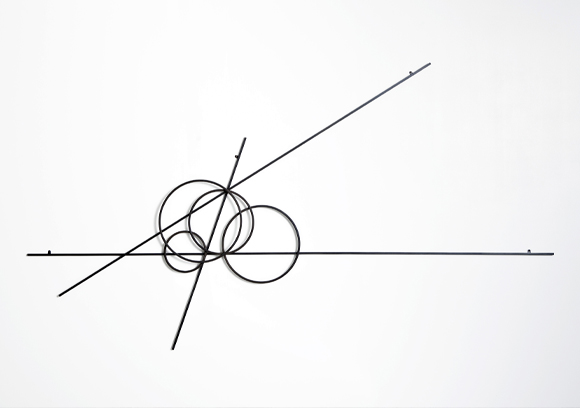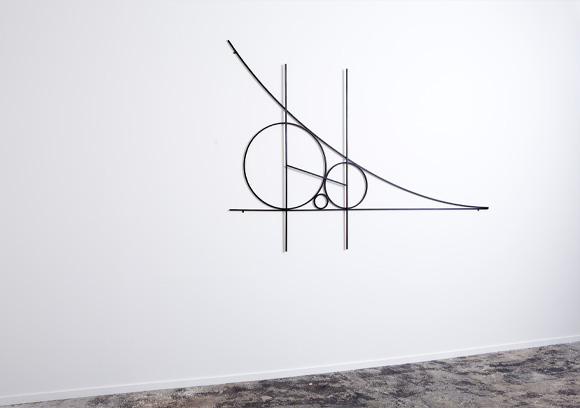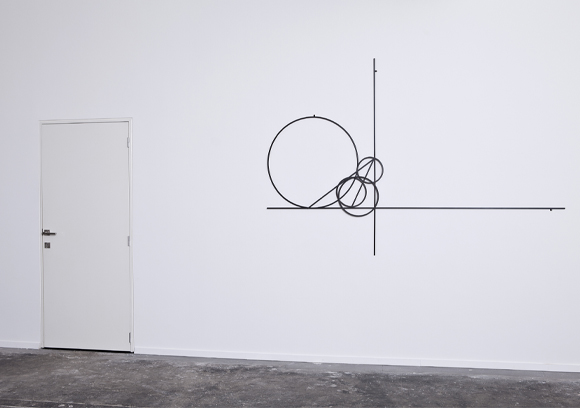| |
|
|
35.
| The Death of the Straight Line 01 |
| |


The Death of the Straight Line (55), 2013, 250 x 140 cm, steel.
Exhibition view from Intersections, Keitelman Gallery, 2013, Brussels.
Courtesy of the artist.
'' The Death of the Straight Line, it seems to avoid any reference to reality. ''
Studio Fatmi, March 2017

The Death of the Straight Line
Exhibition view from Intersections, Keitelman Gallery, 2013, Brussels.

The Death of the Straight Line
Exhibition view from Intersections, Keitelman Gallery, 2013, Brussels.

The Death of the Straight Line
Exhibition view from Intersections, Keitelman Gallery, 2013, Brussels.
|
|
|
|
|
|
La Mort de la Ligne Droite s'offre à une reconnaissance a priori aisée et quasi immédiate. Chacun peut se dire « Je sais ce que c'est. Je reconnais ces formes. Il s'agit tout simplement de lignes et de cercles ». Un graphique assez élémentaire en apparence est en effet tracé autour d'un système de cordonnées cartésiennes à l'aide de lignes droites et de cercles noirs. Un détail vient cependant contredire l'impression d'aspect plat et uniforme lorsqu'on s'approche de l'œuvre - une troisième dimension se révèle, puisqu'il s'avère que lignes et cercles ont été découpés dans du métal, puis fixés directement au mur. Lignes et cercles noirs se superposent, s'entrecoupent et forment plusieurs points d'intersection. Mais les problèmes commencent peut-être à véritablement se poser à la lecture du titre, dont la signification entraîne le regard du spectateur dans un jeu d'allers et retours entre l'œuvre et sa dénomination.
La Mort de la Ligne Droite est une expérimentation géométrique inspirée des cercles de Soddy - prix Nobel de chimie, mathématicien et poète, auteur du fameux "The Kiss precise", lui-même inspiré du théorème de Descartes sur les cercles tangents. "Casablanca Circles", série de photomontages réalisée en 2012, à partir d'images extraites du film "Casablanca", donne également à observer ce type de constructions géométriques se superposant aux photographies des personnages principaux, alors que ceux-ci se rapprochent pour s'embrasser. L'œuvre explore la structure profonde d'un événement en croisant les techniques de la représentation figurative et celles de l'abstraction. La Mort de la Ligne Droite semble pour sa part éviter toute référence au réel. Et cependant le titre de l'œuvre évoque un phénomène fortement ancré dans cette même réalité. La Mort de la Ligne Droite, titre énigmatique au départ, exige peut-être d'être décomposé afin d'en analyser les termes. L'expression fait écho aux scènes typiques de la peinture classique illustrant la mort grandiose de quelque personnage historique - et suggère que ce rôle est ici tenu par la ligne droite.
La Mort de la Ligne Droite fonctionne avec le minimum de moyens expressifs. Et cependant, la perception du diagramme est orientée par le sémantisme dramatisant du titre et suggère qu'un affrontement se déroule également sur le plan géométrique exposé : du côté négatif, des cercles s'opposent à des lignes droites. Plus grands, plus nombreux, plus visibles, ils sectionnent les lignes droites à plusieurs endroits. Les droites ne sont plus : elles sont segments. La dramatisation est contenue, l'émotion mise à distance, afin que toute l'attention se reporte sur la structure elle-même.
Studio Fatmi, Mars 2017.
|
|
The Death of the Straight Line is theoretically up for easy and instant recognition. Anyone can say “I know what this is. I recognize these shapes. They’re just lines and circles.” Indeed, a seemingly elementary graphic is drawn around a system of Cartesian coordinates using straight lines and black circles. But one detail contradicts the impression of a flat and uniform aspect when one moves closer – a third dimension reveals itself, as it turns out these lines and circles are cut out of metal and fixed directly to the wall. Lines and black circles superimpose and cross each other, forming several points of intersection. But problems really start to arise when one reads the title, whose signification pushes the viewer’s into a back and forth movement between the work and its denomination.
The Death of the Straight Line is a geometric experimentation inspired by the circles of Soddy – a Nobel prize winner in chemistry, a mathematician and poet, author of the famous “Kiss Precise”, which was itself inspired by Descartes’ theorem on tangent circles. “Casablanca Circles”, a series of photomontages created in 2012 from images taken from the movie “Casablanca”, also offers this type of geometric constructions superimposed with photographs of the main characters about to engage in a kiss. The work explores the deep structure of an event by combining the techniques of figurative representation and abstraction. As for The Death of the Straight Line, it seems to avoid any reference to reality. Yet the title of the piece evokes a phenomenon that is firmly anchored in that very reality. The Death of the Straight Line, an enigmatic title at first, may need to be decomposed so that its terms can be analyzed. The expression echoes typical scenes in classical painting depicting the grandiose death of some historical character – and suggests that here, that role is held by the straight line.
The Death of the Straight Line works with minimal means of expression. Yet the perception of the diagram is oriented by the dramatic semantics of the title and suggests a confrontation is also taking place in the exhibited geometric plan: on the negative side, circles are opposed to straight lines. They are bigger, more numerous, more visible and cut the straight lines in several points. The lines are no longer lines, but segments. The dramatization is contained and emotion is kept at a distance, so that the viewer’s full attention is turned to the structure itself.
Studio Fatmi, March 2017.
|
|
|
|